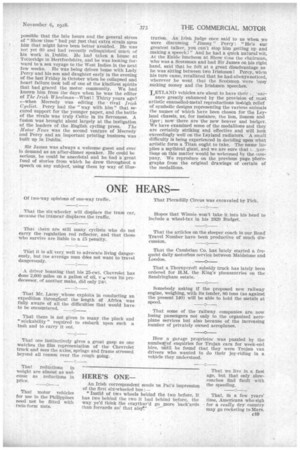Loose Leaves.
Page 2

Page 3

If you've noticed an error in this article please click here to report it so we can fix it.
TYPOGRAPHICAL and other errors creep into a publication with a persistence and a cunning that are little short of demoniacal. Sometimes they elude the watchful eyes of four or five of the keenest scrutineers, only to stand out as "plain as a sore
thumb" when the issue is printed There were two such errors in our Road Travel Number which we would ask our readers to correct in their copies of the journal. In the last line of figures on page 338 a plus mark should precede the figure at In Mr. Marks's article concerning the organization of the bus service of Chesterfield an error occurred in the fourth paragraph on the second page. It dealt with a comparison of lost mileages arising from mechanical defects. The correct figure for petrol buses is .004 per cent, and for trolley-buses .002 per cent. In some of the copies this latter figure el8 appeared as .992 per Cent. (some difference !) and in others, after the correction had been made on the printing machine, it was not altogether clear.
THE most curious error occurred, however, in Mr. Frank Ayton's article upon the progress of the electric _trolley-bus. He was referring to the experiences of the elder Mr. Alfred Baker, formerly general manager of the Birmingham Corporation tramwayS, thus seeking to differentiate between him and his son, who has succeeded him in that office. Unfortunately the word " elder " was interpreted as " late " and passed into print in this way. Mr.. Alfred Baker will be able to repeat Mark Twain's comment that the statement was exaggerated, for he is well and is now undertaking consultations on passenger-traffic transport, for which work, by the way, there is no one in the country better fitted.
IT is with a sense of a real loss that one records the passing of Sir James Campbell Percy. He has not been in good health for some time, and it is
possible that the late hours and the general stress of " Show time" had put just that extra strain upon him that might have been better avoided. He was not yet 60 and had recently relinquished nmeli of his work in, Dublin. He had taken a house at Totteridge in Hertfordshire, and he was looking forward to 'a sea voyage to the West Indies in the next few weeks. He was being driven home with Lady Percy and his son and daughter early in the evening of the last Friday in October when he collapsed and heart failure took toll of one of the kindliest spirits that had graced the motor community. We had known him from the days when he was the editor of The Irish Wheelman—What ! Thirty years ago? —when Meeredy as editing the rival Irish Cyclist. Percy had the "way with him" that secured support for the younger paper, and the battle , of the rivals was truly Celtic in its fierceness. A fusion was brought about largely at the instigation of the leaders of the English cycling press. The Motor News was the second venture of lklecretly and Percy and an important printing business was built up in Dublin.
Sir James was always a welcome guest and ever in demand as an after-dinner speaker. He could be serious, he could be anecdotal and he. had a great fund of stories from which he drew throughout. a speech on any subject, -using them by way of illus
tration. An Irish judge once said to us when we were discussing "Jimmy ". Percy : "He's our greatest talker, you can't stop him getting up and making a speech!" And he had 6, quick natural wit. At the Exideluncheon at Show time the chairman, who was a Scotsman and had Sir James on his right hand, said that he felt at a great disadvantage as he was sitting between two Irishmen! Percy, when his turn came, retaliated that he had always noticed, wherever he went, that the Seamen were busy Making money and the Irishmen speeches.
LEYLAND vehicles are about to have their :ear ance greatly enhanced by the provision of most artistic enamelled-metal reproductions imphigh relief of symbolic designs representing the various animals the names of which have been chosen for the Leyland chassis, as, for instance, the lion, lioness and tiger ; now there are the new beaver and badger. We have examined some of the medallions and they are certainly striking and effective and will look exceedingly well on the Leyland radiator's. A small difficulty is being experienced in deciding upon what artistic form a Titan ought to take. The name implies a mythical giant, and we are sure that z,gestions on this matter would be welcomed by the company. We reproduce on the previous page photographs from the original drawings of certain of the medallions.






























